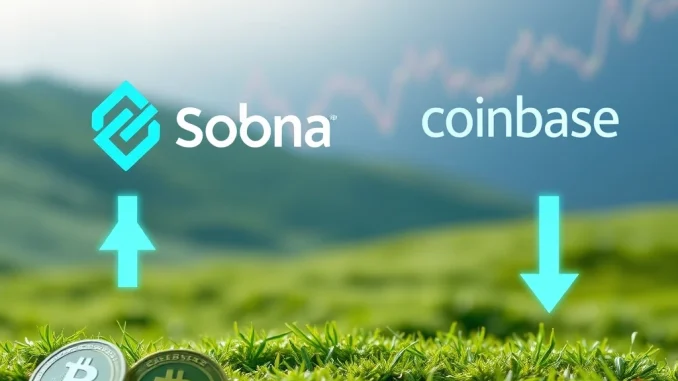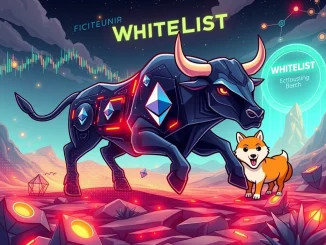
The cryptocurrency world often buzzes with excitement whenever a major exchange like Coinbase announces new listings. It’s usually a signal for potential price pumps and increased liquidity. However, recent Solana listings on Coinbase, specifically for Jito Staked SOL (JitoSOL) and Metaplex (MPLX), have painted a different picture, leaving many scratching their heads. Despite Coinbase’s strategic push into the vibrant Solana ecosystem, the market response has remained surprisingly muted, largely overshadowed by broader macroeconomic uncertainties. What does this tell us about the current state of the crypto market, and what does it mean for these promising Solana-based assets?
Coinbase Expands Solana Listings: What’s the Big Deal?
On July 24, 2025, Coinbase officially added JitoSOL and MPLX to its roster of tradable assets, confirming the news via its Coinbase Assets social media channels. The new trading pairs, JITOSOL-USD and MPLX-USD, became available with a phased rollout depending on liquidity and jurisdictional restrictions. For users, it’s important to note that transfers for both tokens are limited to SPL-compatible addresses, and regulatory constraints mean some regions may not have access.
Coinbase’s decision to list these tokens isn’t arbitrary. It signifies a deliberate strategy to deepen its presence within the Solana ecosystem, which has rapidly grown into a significant player in the blockchain space, known for its high throughput and low transaction costs. Typically, a Coinbase listing is seen as a stamp of approval, often leading to a surge in price due to increased accessibility and perceived legitimacy. However, the anticipated demand for these specific Solana listings did not materialize as expected.
Decoding the Muted Crypto Market Response
The lukewarm reception to the JitoSOL and MPLX listings starkly contrasts with the historical impact of Coinbase announcements. Why the indifference? The primary culprit appears to be the prevailing crypto market uncertainty driven by broader macroeconomic factors. Investors are currently navigating a cautious landscape, heavily influenced by:
- Central Bank Policies: Expectations of prolonged interest rate stability from the Federal Reserve, as noted by analysts, are keeping investors hesitant. Higher interest rates typically make riskier assets like cryptocurrencies less attractive compared to traditional, safer investments.
- Inflationary Concerns: Persistent inflationary pressures continue to loom, eroding purchasing power and leading investors to adopt a more conservative stance.
- Regulatory Ambiguity: The ongoing lack of clear regulatory frameworks in major jurisdictions adds another layer of apprehension, making institutions and retail investors alike wary of committing significant capital.
This environment has dampened speculative fervor across the board, affecting even highly anticipated events like major exchange listings. Unlike past bull runs where any positive news could trigger a rally, the market is now prioritizing fundamental utility and long-term viability over short-term speculative gains. The absence of significant ‘whale-driven’ price action and unconfirmed volume spikes further underscores this cautious sentiment.
JitoSOL: A Deep Dive into Liquid Staking
One of the newly listed assets, Coinbase JitoSOL, is a fascinating innovation within the Solana DeFi landscape. JitoSOL is a liquid staked SOL (LSD) asset issued by the Jito Foundation. It allows users to stake their SOL tokens to earn staking rewards while simultaneously receiving JitoSOL, which can then be used across various decentralized finance (DeFi) protocols. This offers a powerful combination of earning staking yield and maintaining liquidity, addressing a common challenge in traditional staking where assets are locked up.
Proponents of JitoSOL highlight its utility in enhancing capital efficiency within DeFi. For example, users can deposit JitoSOL into lending protocols, use it as collateral, or participate in liquidity pools, thereby compounding their returns. Despite this strong fundamental utility, technical indicators suggest caution. Alva, a crypto analytics firm, observed that JitoSOL’s price showed oversold signals post-announcement, indicating potential short-term stagnation. This suggests that even innovative DeFi solutions are struggling to break through the current market’s inertia.
MPLX Token: Powering Solana’s NFT Infrastructure
The other significant listing is the MPLX token, the governance token for Metaplex. Metaplex is a decentralized protocol and suite of tools that underpins much of Solana’s NFT infrastructure, enabling creators and developers to mint, manage, and trade digital collectibles and programmable tokens efficiently. With renewed interest in NFTs in certain niches, MPLX gained attention as a foundational asset for a key part of the Solana ecosystem.
However, similar to JitoSOL, MPLX faced immediate bearish momentum. Its MACD (Moving Average Convergence Divergence) indicator, a popular technical analysis tool used to identify momentum, remained negative. This indicates that buying pressure was insufficient to overcome selling pressure. While Metaplex’s role in the NFT space is crucial, the broader NFT market has also experienced significant corrections since its peak, and governance tokens often struggle to find consistent price appreciation without robust and continuously expanding utility or strong community engagement. Analysts attribute the mixed technical outlook to the same lack of significant ‘whale’ activity that affected JitoSOL.
Broader Solana News Today and Competitive Landscape
The muted reaction to these listings also sheds light on the intensifying competition among cryptocurrency exchanges. Interestingly, Binance, another crypto giant, had already included JITOSOL and MPLX on its platform earlier in July. While Coinbase’s entry could theoretically enhance liquidity and market depth, the overlapping presence of these tokens on multiple major exchanges has arguably reduced their perceived exclusivity. Traders are now increasingly prioritizing cross-platform accessibility and arbitrage opportunities over the novelty of a specific listing event, further diluting the impact of Coinbase’s move.
This dynamic means that for new listings to truly move the needle, they need more than just exchange visibility; they require compelling narratives, strong community support, and clear, demonstrable utility that resonates even in a challenging market. The broader Solana News Today indicates that while the ecosystem continues to innovate, its immediate market success is intrinsically linked to overcoming the current macroeconomic headwinds and proving its long-term value propositions beyond speculative trading.
What’s Next for JitoSOL and MPLX?
For JitoSOL and MPLX to truly gain traction and overcome the current market apathy, their respective teams must focus on demonstrating real-world adoption and compelling use cases that extend beyond mere price speculation. For JitoSOL, this means fostering deeper integrations within Solana’s DeFi landscape and attracting more users to its liquid staking model. For MPLX, it involves continuing to build out robust NFT infrastructure and fostering innovation within the digital collectibles space, attracting new creators and collectors.
The current lack of momentum indicates that investors are in a ‘wait-and-see’ mode, holding out for clearer signals before committing significant capital. This cautious stance underscores a broader market shift towards utility-driven projects. In the short term, however, the market’s hesitancy—driven by inflationary concerns, regulatory uncertainties, and broader economic trends—suggests that a patient, fundamentals-focused approach will dominate.
Conclusion: A New Era for Crypto Listings?
The recent Coinbase listings of JitoSOL and MPLX serve as a stark reminder that the cryptocurrency market is maturing. The days when any new listing on a major exchange guaranteed a price surge might be behind us, at least for now. While Coinbase’s strategic expansion into the Solana ecosystem is a positive long-term sign for the network, the immediate muted response highlights the profound impact of macroeconomic factors and increased exchange competition. For JitoSOL, MPLX, and indeed the entire crypto market, sustained growth will likely depend less on listing events and more on demonstrable utility, robust adoption, and a clearer global economic outlook.
Frequently Asked Questions (FAQs)
Q1: Why did Coinbase list JitoSOL and MPLX?
Coinbase listed JitoSOL and MPLX as part of its strategic expansion into the Solana ecosystem. This move aims to offer users more diverse trading options and tap into the growing utility of Solana-based tokens, particularly in DeFi (JitoSOL) and NFTs (MPLX).
Q2: What is JitoSOL and why is it important?
JitoSOL (Jito Staked SOL) is a liquid staking derivative (LSD) token on Solana. It allows users to stake their SOL to earn rewards while simultaneously receiving JitoSOL, which remains liquid and can be used in various DeFi protocols. This helps users earn staking yield without locking up their capital, enhancing capital efficiency.
Q3: What is MPLX and its role in the Solana ecosystem?
MPLX is the governance token for Metaplex, a decentralized protocol that provides the foundational infrastructure for NFTs on the Solana blockchain. Metaplex enables creators and developers to mint, manage, and trade digital collectibles, making MPLX crucial for the governance and development of Solana’s NFT landscape.
Q4: Why was the market response to these listings muted?
The market response was muted primarily due to broader macroeconomic factors, including uncertainty around central bank policies (like the Federal Reserve’s interest rates), persistent inflationary concerns, and general regulatory ambiguity. Additionally, increased competition among exchanges (with Binance already listing these tokens) reduced the perceived exclusivity of the Coinbase listings.
Q5: What are the technical indicators mentioned for JitoSOL and MPLX?
For JitoSOL, crypto analytics firm Alva noted ‘oversold signals,’ suggesting that its price had fallen significantly and might be due for a bounce or stagnation. For MPLX, its MACD (Moving Average Convergence Divergence) indicator remained negative, which typically signals bearish momentum or a lack of buying interest.
Q6: What needs to happen for JitoSOL and MPLX to gain traction?
For JitoSOL and MPLX to gain significant traction, their respective projects need to demonstrate clear, real-world adoption and compelling use cases beyond speculative trading. A clearer macroeconomic outlook and increased institutional adoption would also be crucial in attracting more capital and sustained interest.




Be the first to comment